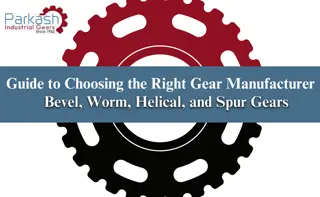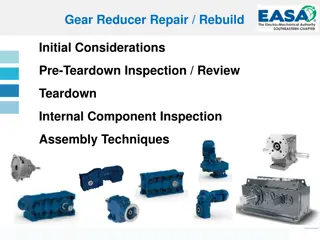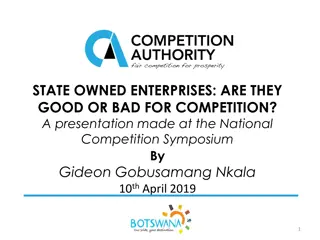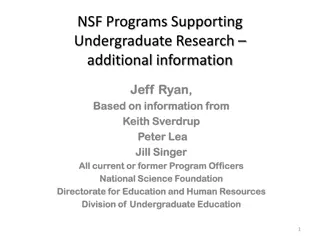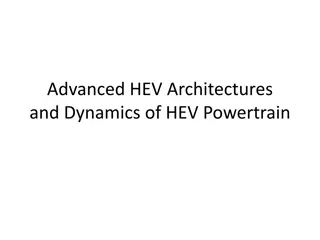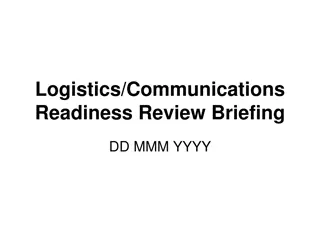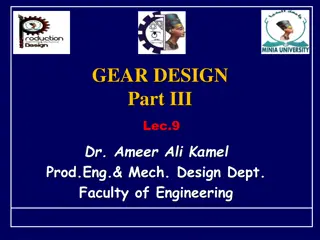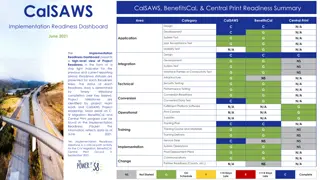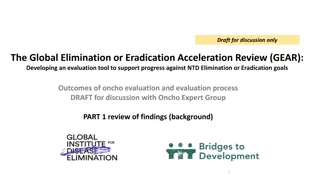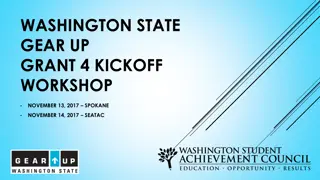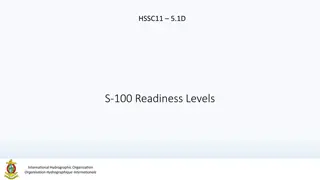Gaining Early Awareness and Readiness for Undergraduate Programs (GEAR UP) FY 2023 States Competition Overview
This document provides an overview of the GEAR UP FY 2023 States Competition, covering program funding, authority legislation, mission, objectives, and application requirements. The GEAR UP program aims to support low-income students, including those with disabilities, in obtaining a secondary school diploma and succeeding in postsecondary education. Key topics include program funding, selection criteria, competitive priorities, and submission logistics.
Download Presentation

Please find below an Image/Link to download the presentation.
The content on the website is provided AS IS for your information and personal use only. It may not be sold, licensed, or shared on other websites without obtaining consent from the author.If you encounter any issues during the download, it is possible that the publisher has removed the file from their server.
You are allowed to download the files provided on this website for personal or commercial use, subject to the condition that they are used lawfully. All files are the property of their respective owners.
The content on the website is provided AS IS for your information and personal use only. It may not be sold, licensed, or shared on other websites without obtaining consent from the author.
E N D
Presentation Transcript
Gaining Early Awareness and Readiness for Undergraduate Programs (GEAR UP) FY 2023 States Competition Note: This workshop is being recorded. By joining this webinar you give consent to being recorded. 1
This document is a brief summary of the program regulations and application requirements. Do not rely solely on the information in this document. Please refer to the Notice Inviting Applications, program statute, and program regulations published in the Federal Register for additional information, as these are the official documents governing the competition. 2
Workshop Overview Before Break: FY 2023 GEAR UP funding levels Program Authority, Mission, and Objectives State Program Overview, Required & Permissible Activities Implementation Models Scholarship Requirement Matching Requirement Budget After Break: GEAR UP Selection Criteria Competitive Preference Priorities Formatting Required Forms Submission Logistics Process/Timeline Questions and Answers 3
Program Funding FY 2023 Appropriation: $388,000,000 Estimated Funds Available for New Awards: $20,000,000 State : 4-5 New Awards (estimated) Maximum Award: $5 million 4
Authority Legislation: Section 404A 404H of the Higher Education Act of 1965 (HEA), as amended Regulations: 34 CFR Part 694 As seen on the GEAR UP homepage: https://www2.ed.gov/programs/gearup/legislation.html 5
GEAR UP Mission Section 404A(a) of the HEA The GEAR UP program is a discretionary grant program that encourages applicants to provide support and maintain a commitment to eligible low-income students, including students with disabilities, to assist the students in obtaining a secondary school diploma and to prepare for and succeed in postsecondary education. 6
Objectives Increase the academic performance and preparation for postsecondary education for students. Increase the rate of high school graduation and participation in postsecondary education for students. Increase the educational expectations for students and increase student and family knowledge of postsecondary education options, preparation and financing. 7
State Projects Eligible Applicants: The 50 States, plus: Puerto Rico, District of Columbia, Guam, American Samoa, U.S. Virgin Islands, Commonwealth of the Northern Mariana Islands, and the Freely Associated States. Range of Awards: $3,000,000 $5,000,000 Average Size of Awards: $4,000,000 Maximum Award: $5,000,000 per year Note: Only States without an active State GEAR UP grant, or scheduled to end on/before 9/30/23 Length of Award: 6 or 7 years 8
State Projects 34 CFR 694.17 The governor of a State must designate, in writing, which State agency can apply for and administer the GEAR UP State grant. State Applicant Eligibility Form A State may only have one open, service-providing State GEAR UP project at a time. The State may opt to have more than one entity deliver the services. States may implement the whole-grade, priority students, and/or public housing models. 9
State Projects- Allocation of Funds Section 404E(a) of the HEA; 694.14 of the GEAR UP regulations Fifty percent of funds for State projects must be used to establish or maintain a financial assistance program that awards scholarships to students. Fifty percent of funds for State projects can be used for required and permissible activities. 10
Required Activities Section 404D(a) of the HEA; 694.21 of GEAR UP program regulations Provide information regarding financial aid for postsecondary education for participating students Encourage student enrollment in rigorous or challenging curricula and coursework, in order to reduce the need for remedial coursework at the postsecondary level Improve the number of participating students who obtain a secondary school diploma and complete applications for and enroll in a program of postsecondary education For State grantees, providing Scholarships 11
Permissible Activities Section 404D(b) of the HEA; 694.22 of GEAR UP program regulations Providing tutors and mentors Conducting outreach activities to recruit priority students Supporting development of rigorous academic curricula, including college prep, Advanced Placement, or I.B. Supporting dual or concurrent enrollment programs Providing intensive extended school day, school year or summer programs Introducing students to IHEs through college visits Fostering and improving parent and family involvement Disseminating information Other activities designed to ensure secondary school completion and postsecondary enrollment for at-risk children 12
Additional Allowable Activities for States Section 404D(c) of the HEA; 694.23 of GEAR UP program regulations Providing technical assistance to secondary schools or GEAR UP Partnership grants in your State Providing professional development to individuals working with GEAR UP student cohorts Providing strategies and activities that align efforts in the State to prepare eligible students to attend and succeed in postsecondary education Disseminating information on the use of scientifically valid research and best practices to improve services to eligible students Working to align State academic standards and curricula with the expectations of postsecondary institutions and employers And more 13
Implementation Models Cohort Model Whole-grade Public housing Priority Students Model Combination of Both Cohort model must begin serving students no later than 7th grade. 14
Cohort Model Section 404B(d) of HEA Whole-Grade Cohort The whole-grade model requires that services must be provided to all students in a participating grade level or cohort until that grade level moves on to the next school. Serves a participating school that has a 7th grade and at least 50 percent of the students enrolled in the school must be eligible for free or reduced-price lunch . Once the cohort moves to another school, a GEAR UP project must continue to provide services to at least those students in the cohort who attend participating secondary schools that enroll a substantial majority of the students in the cohort. 15
Cohort Model (contd) Public Housing Cohort An entire grade level of students, beginning no later than the 7th grade who reside in public housing as defined by the U.S. Housing Act of 1937. The Public Housing Agency in your area is the best source for obtaining information regarding which publicly assisted housing facilities are eligible under the GEAR UP program. Names and addresses of Public Housing Authorities can be obtained by calling the U.S. Department of Housing and Urban Development (HUD) local offices or through the HUD website at http://www.hud.gov. 16
Priority Students Model Section 404D(d) of HEA Students in secondary schools through 12th grade who are eligible: (1) To be counted under section 1124(c) of the Elementary and Secondary Education Act of 1965 (Title I); (Free or Reduced Lunch) (2) Is eligible for assistance under a State program funded under Part A or E of Title IV of the Social Security Act (3) Eligible for assistance under subtitle B of title VII of the McKinney-Vento Homeless Assistance Act or (4) Otherwise considered to be a disconnected student 17
Scholarships Sections 404E(d) & 404 E(g)of HEA -Minimum Scholarship Amount = Minimum Pell amount when the participant goes to college -Students eligible for a GEAR UP scholarship: GEAR UP student; Less than 22 years of age; Possess a high school diploma or recognized equivalent; and Enrolled or accepted for enrollment at Institutions of Higher Education (IHE). 18
Scholarships (contd) Scholarship funds must be held in reserve -at least the minimum scholarship amount multiplied by the estimated number of eligible students. Should estimate based at minimum on this year s Pell amount, but we recommend you include additional funds to make sure you have enough for when the scholarships are needed. However, State projects using a priority model may award scholarships directly rather than holding funds in reserve, if applicable. 19
21st Century Scholar Certificate Section 404F of HEA All participating GEAR UP students must receive a 21st Century Scholar Certificate. The reverse side of the certificate must include a summary of how much Federal aid may be available to students based on income. The grantees may use GEAR UP funds to design and print the certificates. 20
Scholarship Waiver Applicants may request an exception from the requirement that 50% of grant funds be used for scholarships, if they have another means or multiple means of providing scholarships that meet the minimum Pell Grant requirements. Request and justification for waiver should be indicated on the applicant s Program Profile Page; may also be attach an additional page(s). 21
Scholarship Waiver Applicants must provide documentation of those other means, such as: A comprehensive list of other sources of aid that reduce or eliminate the need for the grantee to provide GEAR UP scholarships to eligible students out of their federal funding; The projected number of students that the grantee expects to receive aid through those sources; An estimate of the number of students eligible for a GEAR UP scholarship that are not expected to receive aid through those other sources, if any. 22
Matching Requirements Section 404C(b) of HEA State Projects Required to match the federal contribution dollar- for-dollar. Specifically, the non-Federal contribution must equal at least 50 percent of the total project costs. Matching may be provided in-cash or in-kind and may be accrued over the full duration of the grant award period. However, grantees must make substantial progress towards meeting the matching requirement in each year of the grant. 23
Matching Requirements The applicant is the fiscal agent and is responsible for documenting all matching contributions for the entire grant period. Matching contributions must be made from any non- Federal source and must be documented. Matching contributions and cost-sharing must be adequately documented and the value of in-kind contributions must be clearly maintained. 24
Matching Waiver Options Section 404(C)(b)(2) of HEA Partnerships only. States ARE NOT eligible to waive any portion of the matching component. 25
Program Budget Two places to indicate your budget: First Year Budget Narrative Project Budget Summary Form All expenditures must be allowable, allocable, reasonable, and necessary. Indirect Costs = limited to entity s negotiated indirect cost rate agreement, or 8% of modified total direct cost base, whichever is less. (see 34 CFR 694.11) 26
First Year Budget Narrative All applicants must include a budget narrative for each budget line item for the first year, which explains: The basis for estimating the costs of professional personnel salaries, benefits, project staff travel, materials and supplies, consultants and subcontracts, indirect costs, and any projected expenditures; The basis for how your scholarship total is calculated; How the major cost items relate to the proposed activities; The costs of evaluation; and A detailed description explaining any matching resources provided. 27
Project Budget Summary PROJECT BUDGET SUMMARY FORM FEDERAL FUNDS REQUESTED FROM THE GEAR UP GRANT PROGRAM YEAR 1 2 3 4 1. Salaries and Wages Direct Costs: YEAR YEAR YEAR YEAR 5 YEAR 6 YEAR 7 TOTAL The P.B.S. form is the official funding request amount, so please be accurate! 2. Employee Benefits 3. Travel 4. Materials and Supplies 5. Consultants & Contracts 6. Other A.Total Direct Costs: (Sum of lines 1-6) B.Total Indirect Costs*: (cannot be greater than 8% of Total Direct Costs) C.Equipment D. Scholarships/ Tuition Assistance E. TOTAL REQUESTED A + B+ C+D (Enter these figures in Item 7 of the Title Page) All items must be addressed in the detailed budget justification *Indirect Cost Information (To Be Completed by Your Business Office): If you are requesting reimbursement for indirect costs on line B, please answer the following questions: (1)Do you have an Indirect Cost Rate Agreement approved by the Federal government? ____Yes ____ No (2)If yes, please provide the following information: Period Covered by the Indirect Cost Rate Agreement: From: ___/___/______ To: ___/___/______ (mm/dd/yyyy) Approving Federal agency: ____ ED ____ Other (please specify): ________ (3)For Restricted Rate Programs (check one) -- Are you using a restricted indirect cost rate that: ___Is included in your approved Indirect Cost Rate Agreement? or ___ Complies with 34 CFR 76.564(c)(2)? 28
Section Need Quality of Project Design Adequacy of Resources Quality of Project Personnel Quality of Project Evaluation Total State Projects Competitive Preference Priorities 1. Successful State GEAR UP grantee prior to August 14, 2008 2. Increasing Postsecondary Education Access, Affordability, Completion and Post-Enrollment Success Maximum Points 15 30 15 20 20 100 2 8 30
Need for the Project - 15 points In determining the need for the proposed project, the Secretary considers the following factors: The magnitude or severity of the problem to be addressed by the proposed project (up to 5 points); The extent to which the proposed project will provide services or otherwise address the needs of students at risk of educational failure (up to 5 points), and The extent to which the proposed project will focus on serving or otherwise addressing the needs of disadvantaged individuals (up to 5 points). 31
Project Design - 30 points In determining the quality of project design, the Secretary considers the following factors: The extent to which the goals, objectives, and outcomes to be achieved by the proposed project are clearly specified and measurable; (up to 8 points); The extent to which the proposed project demonstrates a rationale (as defined in the NIA). (up to 7 points); Logic Model! Just an Example: 32
Project Design contd The extent to which the proposed project represents an exceptional approach for meeting statutory purposes and requirements (up to 8 points); and How the applicant will ensure that a diversity of perspectives are brought to bear in the operation of the proposed project, including those of parents, teachers, the business community, a variety of disciplinary and professional fields, recipients or beneficiaries of services, or others, as appropriate (up to 7 points). 33
Adequacy of Resources- 15 Points In determining the adequacy of resources for the proposed project, the Secretary considers: The adequacy of support, including facilities, equipment, supplies, and other resources, from the applicant organization or the lead applicant organization and the relevance and demonstrated commitment of each partner in the proposed project to the implementation and success of the project (up to 5 points); 34
Adequacy of Resources, continued The extent to which the costs are reasonable in relation to the number of persons to be served and to the anticipated results and benefits (up to 5 points); and The potential for continued support of the project after Federal funding ends, including, as appropriate, the demonstrated commitment of appropriate entities to such support (up to 5 points). 35
Project Personnel - 20 Points The Secretary considers the following factors: The extent to which the applicant encourages applications for employment from persons who are members of groups that have traditionally been underrepresented based on race, color, national origin, gender, age or disability. (up to 5 points); The qualifications, including relevant training and experience, of the project director or principal investigator (up to 5 points); The qualifications, including relevant training and experience of key personnel. (up to 5 points); and The extent to which the time commitments of the project director and principal investigator and other key project personnel are appropriate and adequate to meet the objectives of the proposed project (up to 5 points). 36
Project Evaluation - 20 Points The Secretary considers the following factors: The extent to which the methods of evaluation include the use of objective performance measures that are clearly related to the intended outcomes of the project and will produce quantitative and qualitative data to the extent possible (up to 10 points); The extent to which the methods of evaluation will provide performance feedback and permit periodic assessment of progress toward achieving intended outcomes (up to 10 points). 37
Competitive Preference Priority #1: Successful State GEAR UP grant prior to 8/14/08 (Up to 2 points). We give priority to an eligible applicant for a State GEAR UP grant that has: (a) carried out a successful State GEAR UP grant prior to August 14, 2008, determined on the basis of data (including outcomes data) submitted by the applicant as part of its annual and final performance reports from prior GEAR UP State grants administered by the applicant and the applicant s history of compliance with applicable statutory and regulatory requirements; and (b) a prior demonstrated commitment to early intervention leading to college access through collaboration and replication of successful strategies. 38
New for 2023 CPP #2: Increasing Postsecondary Education Access, Affordability, Completion and Post-Enrollment Success (up to 8 points) A) Establishing a system of high-quality data collection and analysis, such as data on persistence, retention, completion, and post-college outcomes, for transparency, accountability, and institutional improvement (up to 4 points); and B) Providing secondary school students with access to career exploration and advising opportunities to help students make informed decisions about their postsecondary enrollment decisions and to place them on a career path (up to 4 points). 39
Recommended Formatting 65 page narrative, plus up to 3 pages per CPP. Double spaced (no more than three lines per vertical inch) all text in the application narrative, excluding titles, headings, footnotes, quotations, references, captions. Use a font that is either 12 point or larger Use Times New Roman, Courier, Courier New or Arial. 40
Departmental Standard Attachments (Forms, Assurances, and Certifications) Application for Federal Assistance (SF-424) Department of Education Supplemental Information for SF-424 GEPA Section 427 Requirement (different for 2023) Grants.gov - Lobbying form (formerly ED form 80-0013) Disclosure of Lobbying Activities (SF-LLL) 41
Program-Specific Forms ED Abstract Form (one-page maximum) Project Narrative Form (Selection Criteria and Priorities) State Applicant Eligibility Form Program Profile Form Project Budget Summary Form First-Year Budget Narrative Document Scholarship Waiver Request, if applicable 42
State Applicant Eligibility Form -signed by Governor 43
Program Profile All critical elements of the application summarized here Critical to Department s processing of applications Includes: Federal Funds Requested Allocation: Activities & Scholarships CPPs Partners Matching Funds Implementation Model Indirect Cost Rate Target Schools Number of Students Served Services Provided 44
Project Budget Summary Form -Both Federal and Non-Federal Sides! -Our official recording of your requested funding 45
First Year Budget Narrative 46
Electronic Submission Submission of applications through Grants.gov, http://www.grants.gov Grants.gov technical support: support@grants.gov or 1-800-518-4726 Your application has to be submitted by 11:59:59 p.m. (Eastern Time) on or before the due date of 7/31/2023 Request a waiver for electronic submission Applications must be submitted in PDF Be sure to make sure your institution s UEI number is active in SAM.gov 47
Application Process Submit application via www.Grants.gov A panel of peer reviewers, who are not federal employees, will review the application. The panel will prepare an evaluation of the application and assign points to each selection criterion. Scores from the three reviewers will be averaged to determine one numeric score for the application. Final scores are ranked in order, highest to lowest. All successful applicants will receive a six or seven year grant award. 48
Timeline -Notice Inviting Applications published: June 1, 2023 -Deadline date for submission of applications: July 31, 2023 -Technical Review Process August 2023 -Announcement of awards - September 2023 49





